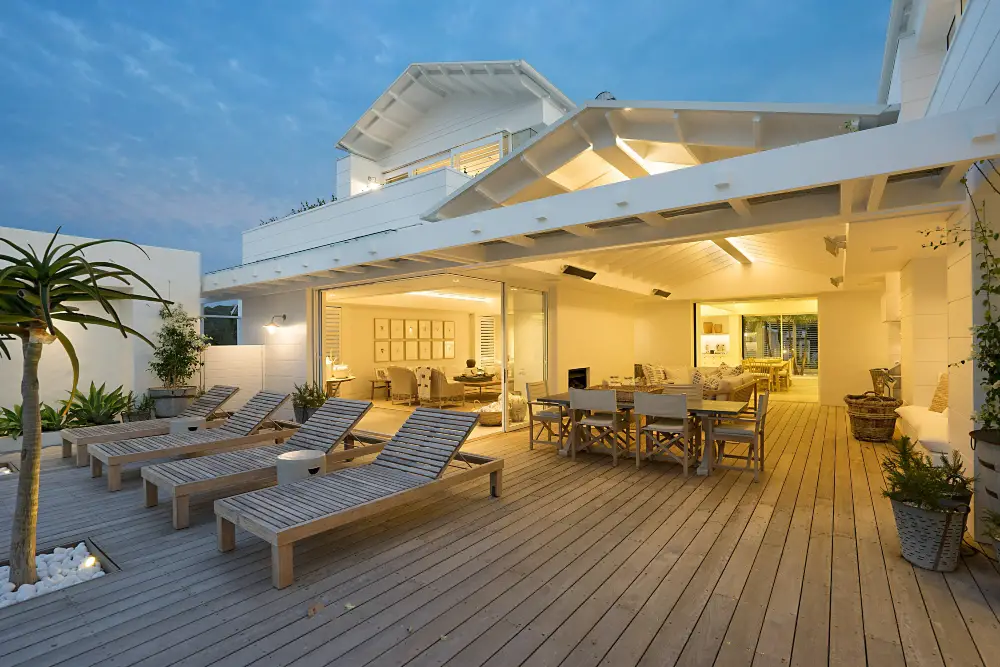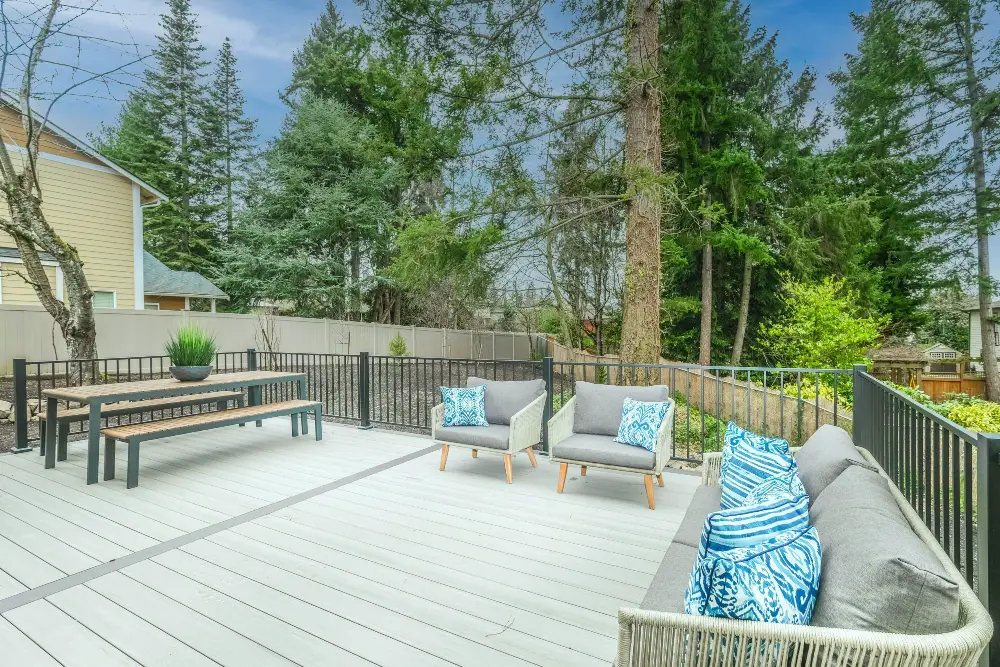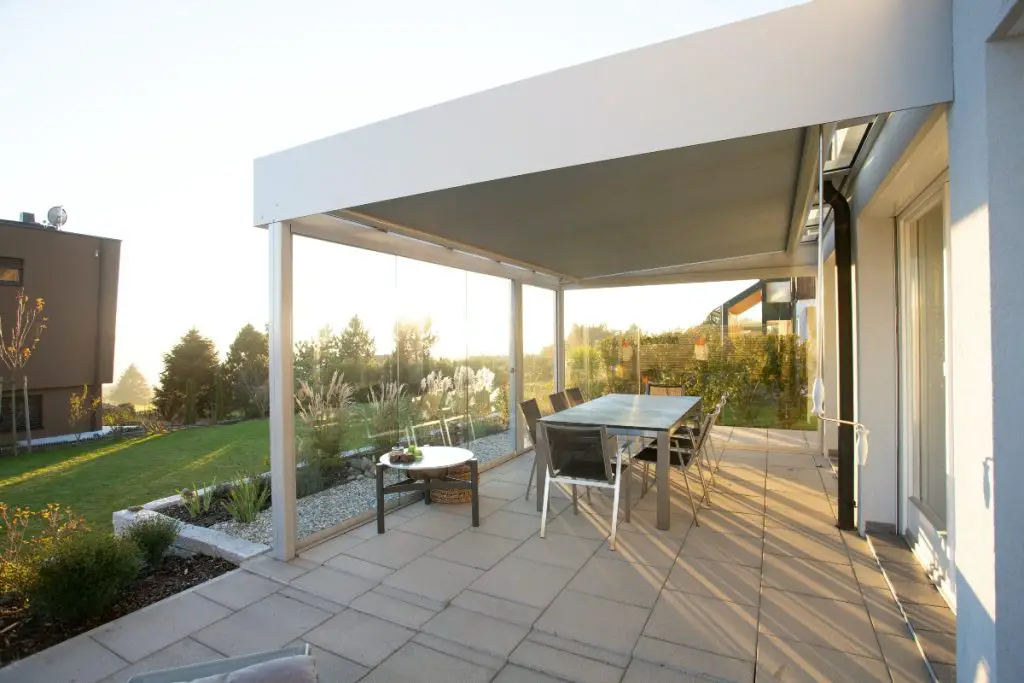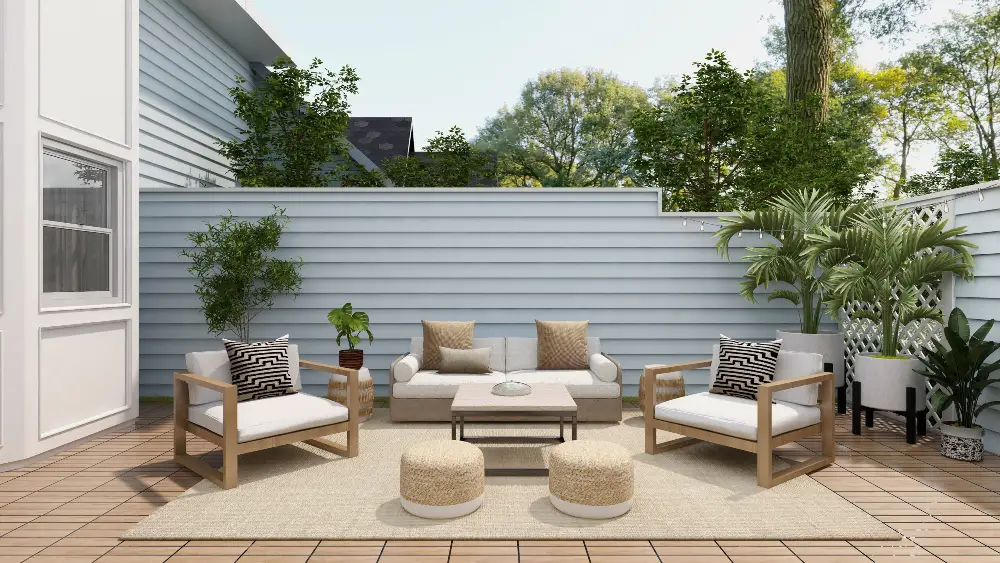Outdoor covered patios offer a perfect blend of comfort and nature. Yet, weather elements can challenge their charm. This article provides essential tips for weatherproofing your outdoor covered patio. We aim to help you enhance its durability and maintain its allure all year round.
Contents
- 1 Understanding Weather Challenges
- 2 Tips on Weatherproofing Your Outdoor Covered Patio
- 3 Regular Maintenance and Care
- 4 FAQ on Weatherproofing Outdoor Covered Patio
- 4.1 How often should I apply sealant to wooden furniture on my outdoor covered patio?
- 4.2 Can I use indoor furniture on my outdoor covered patio?
- 4.3 What is the best way to clean mold off of outdoor fabrics?
- 4.4 How can I protect my outdoor covered patio from strong winds?
- 4.5 What are the best plants to use as natural windbreaks for my outdoor covered patio?
- 4.6 How do I control my outdoor patio temperature during extreme seasons?
- 4.7 Are misting systems effective in humid climates?
- 4.8 How can I protect my patio furniture during winter?
- 4.9 What type of lighting is best for my outdoor covered patio?
- 4.10 Can I install a fire pit on my wooden deck patio?
- 5 Conclusion
Understanding Weather Challenges
Your outdoor covered patio can be your haven, but weather conditions pose significant challenges. By understanding these challenges, you can better protect and enjoy your space throughout the year.
Impact of Sun and Heat
The sun’s relentless rays can significantly affect your outdoor covered patio. Prolonged exposure to sunlight fades furniture and can create an uncomfortably hot environment. To combat these issues, consider the following strategies:
- Shade Solutions: Installing retractable awnings or sunshades can provide relief from direct sunlight. These additions allow you to control the sun your patio receives throughout the day.
- Reflective Materials: Use furniture and accessories with light-colored, UV-resistant fabrics. These materials reflect sunlight, helping to keep the area cooler and preventing fading.
- Cooling Systems: Incorporating misting systems or outdoor fans can reduce the temperature of your outdoor covered patio, making it more comfortable during hot days.
Dealing with Rain and Moisture
Rain and moisture present another set of challenges for your outdoor covered patio. Keeping this space dry and free from water damage requires a proactive approach:
- Effective Drainage: Ensure your patio has adequate drainage to prevent water accumulation. Installing gutters and downspouts can direct rainwater away from your patio area.
- Waterproof Furniture and Fabrics: Opt for waterproof or water-resistant furniture. Materials like synthetic rattan, aluminum, and treated wood are ideal for withstanding moisture.
- Protective Sealants: Regularly apply sealants to wooden surfaces and structures. These products create a moisture-resistant barrier, extending the life of your patio and its furnishings.
- Outdoor Rugs and Mats: Use outdoor rugs and mats made from synthetic fibers. These materials dry quickly and resist mold and mildew, helping to keep your patio clean and dry.
Cold Weather Considerations
Chilly temperatures can often deter the use of your outdoor covered patio. However, with the right approach, you can transform it into a cozy retreat during the colder months. Here are key strategies to consider:
- Heating Solutions: Portable heaters, such as propane patio heaters or electric infrared heaters, effectively warm the space. These heaters come in various styles and sizes, making it easy to find one that suits your patio’s aesthetic and size.
- Enclosures and Curtains: Adding clear vinyl enclosures or heavy-duty outdoor curtains can create a barrier against cold winds while allowing you to enjoy the view. This setup also helps to retain heat within the patio area.
- Comfy Textiles: Incorporate warm, thick textiles like blankets and throw pillows. Opt for outdoor-friendly fabrics that can withstand cooler temperatures, such as fleece or waterproof velvets.
- Fire Pits and Fireplaces: A fire pit or an outdoor fireplace can be a centerpiece that provides warmth and ambiance. Ensure that any fire element is safely installed and used according to safety guidelines.
Tips on Weatherproofing Your Outdoor Covered Patio
To protect it properly, you must consider the elements that can damage your patio. Below are the foolproof tips on shielding your outdoor covered patio from the weather.
Choosing the Right Materials
Selecting the appropriate materials is crucial for the longevity and aesthetics of your outdoor covered patio. The right choices can withstand various weather conditions, reducing maintenance and enhancing enjoyment. Here are essential considerations:

Durable Furniture for Your Outdoor Covered Patio
When furnishing your outdoor covered patio, durability should be a top priority. Here’s a deeper look at the best materials:
- Teak: Renowned for its strength and natural weather resistance, teak is an excellent choice. It naturally repels water and doesn’t easily warp or crack. Over time, teak develops a silver-gray patina that adds to its charm without reducing its durability.
- Wrought Iron: Known for its classic look and sturdiness, wrought iron furniture can withstand harsh weather conditions. It’s heavy, which makes it ideal for windy environments. To prevent rust, look for powder-coated wrought iron.
- High-Quality Synthetic Resin: Synthetic resin is becoming increasingly popular due to its lightweight, low maintenance, and resistance to fading, cracking, and peeling. It mimics the look of wicker or rattan but offers superior longevity.
Choosing these materials ensures that your outdoor covered patio remains functional and stylish for years.
Weather-Resistant Fabrics for Your Outdoor Covered Patio
The right fabric choices are crucial for maintaining the appearance and comfort of your outdoor covered patio. Here’s more on weather-resistant fabrics:
- Sunbrella and Similar Fabrics: These fabrics are designed to endure harsh sunlight, rain, and other outdoor elements. They resist fading and mildew, maintaining their color and integrity over time.
- Ease of Maintenance: Besides their durability, these fabrics are easy to clean. Most spills and stains can be wiped away, essential for outdoor settings.
- Variety of Designs: Available in various colors and patterns, these fabrics allow you to personalize your outdoor covered patio while ensuring long-lasting beauty and comfort.
Incorporating these fabrics into your patio design means cushions, curtains, and upholstery will remain vibrant and inviting, no matter the weather.
Quality Flooring for Your Outdoor Covered Patio
Flooring is a fundamental aspect of your outdoor covered patio in terms of aesthetics and durability. Here’s a closer look at the best flooring options:
- Natural Stone: Its timeless appeal and robustness make it a perfect choice for outdoor patios. It’s naturally slip-resistant and can withstand various weather conditions. Granite, slate, and bluestone are popular options, each offering unique colors and textures.
- Concrete Pavers: These provide a versatile and cost-effective flooring solution. Concrete pavers are available in various colors and styles, mimicking the look of natural stone or brick. They are also easy to replace if damage occurs.
- Treated Wood Decking: Wood decking adds warmth and a natural feel to your outdoor covered patio. Treated wood is resistant to rot, insects, and moisture, making it durable. Regular maintenance will keep the wood decking looking fresh and new.
Each of these flooring options offers a combination of durability and style, ensuring your outdoor covered patio remains a beautiful and stable space for years to come.
Protective Coatings and Sealants for Your Outdoor Covered Patio
Maintaining the integrity of your outdoor covered patio materials is crucial. Protective coatings and sealants play a significant role in this:
- Wood Coatings: For wooden surfaces, a good quality sealant or wood stain can prevent water damage, rot, and sun wear. These coatings need to be reapplied periodically, usually every one to three years, depending on exposure and weather conditions.
- Metal Surface Coatings: Metal furniture and fixtures can be kept rust-free and look great with the right protective coatings. Powder coating is especially effective for wrought iron or steel, providing a durable and attractive finish.
- Stone and Concrete Sealants: Applying sealant to stone or concrete flooring not only protects against stains and moisture but can also enhance the color and texture of the material. Relying on sealants every two to five years is recommended to maintain the protective layer.
Using these protective products ensures that the various elements of your outdoor covered patio continue to look great and last longer, saving time and money in the long run.
Effective Water Drainage Systems
Proper water drainage is vital for maintaining the integrity and usability of your outdoor covered patio. Ineffective drainage can lead to water damage and a less enjoyable patio experience. Here are the key components of an effective water drainage system:
- Slope and Grading: Ensure your patio is properly graded to allow water to flow away from the patio area. Even a slight slope can significantly reduce water accumulation.
- Gutters and Downspouts: Installing gutters and downspouts can effectively channel rainwater away from your patio. This helps prevent puddling and potential water damage to both the patio and your home’s foundation.
- Drainage Solutions in Flooring: If you use paving stones or concrete, consider permeable options or installing a proper drainage system underneath. This allows water to seep through and disperse into the ground, reducing standing water on your patio surface.
- French Drains and Dry Wells: Incorporating a French drain or a dry well can be a great solution for areas with heavy rainfall. These systems collect and redirect water, keeping your outdoor covered patio dry and free from waterlogging.
Wind Protection Strategies
Wind can be a disruptive element for your outdoor covered patio, but you can minimize its impact with effective strategies. Here are some practical ways to protect your patio from strong winds:
- Windbreaks: Planting shrubs or trees around your patio can be natural windbreaks. Choose species native to your area and can withstand local wind conditions.
- Outdoor Screens and Panels: Installing sturdy screens or panels around your patio can block wind while maintaining the aesthetic appeal. These can be made of wood, metal, or heavy-duty fabric.
- Retractable Enclosures: For a flexible solution, consider retractable enclosures. These can be extended to provide wind protection when needed and retracted to open up the space on calmer days.
- Strategic Furniture Placement: Arrange your patio furniture in a way that creates a natural barrier against the wind. Heavier pieces like sofas or large planters can be placed on the windward side to help block gusts.

Integrating Weatherproof Accessories
Adding weatherproof accessories to your outdoor covered patio not only enhances its functionality but also contributes to its overall charm. Here are some key accessories to consider:
- Durable Outdoor Rugs: Choose rugs made from synthetic fibers like polypropylene or nylon. These materials are mold- and mildew-resistant and easy to clean, making them ideal for outdoor use.
- Protective Covers: Invest in high-quality covers for your patio furniture and accessories. These covers should be waterproof and UV-resistant to protect against rain, sun, and dust.
- Lighting Solutions: Opt for weatherproof lighting fixtures to add ambiance to your patio. Solar-powered lights or LED options are energy-efficient and durable in various weather conditions.
- Decorative Elements: Incorporate weather-resistant decor such as metal wall art, stone sculptures, or ceramic planters. These elements add personality to your patio while sturdy enough to withstand outdoor conditions.
- Outdoor Curtains: These can provide privacy and protection from the elements. Look for curtains made from durable, weather-resistant fabrics that can withstand sun exposure and moisture.
- Weatherproof Art and Mirrors: Add visual interest with outdoor-safe art pieces and mirrors. These should be designed to resist fading and moisture damage.
- Planters and Gardening Accessories: Use planters made from materials like resin, concrete, or treated wood. These are durable and add a natural, lively touch to your patio.
- Outdoor Fire Elements: Consider adding a weather-resistant fire pit or a built-in fireplace. These features not only provide warmth but also create a cozy atmosphere.
- Patio Umbrellas: A high-quality, durable patio umbrella offers additional shade and protection from the sun and light rain. Look for options with UV-resistant fabric and a sturdy frame.
- Deck Boxes and Storage Solutions: Weatherproof deck boxes store cushions, toys, and gardening tools. They help keep your patio organized and clutter-free.
- Wind Chimes and Mobiles: These add a pleasant auditory element to your space. Choose designs made from weather-resistant materials like aluminum or bamboo.
Maintaining Temperature Control
Ensuring a comfortable temperature year-round in your outdoor covered patio can significantly enhance your enjoyment of this space. Here are strategies to maintain an ideal temperature:
Heating Solutions for Cooler Months in Your Outdoor Covered Patio
Creating a warm and inviting atmosphere in your outdoor covered patio during cooler months is essential. Here are expanded heating options:
- Built-in Fireplaces and Fire Pits: Integrating a permanent heating element like a fireplace or fire pit adds both warmth and aesthetic appeal. It becomes a natural gathering spot, enhancing the ambiance of your outdoor covered patio.
- Enclosures: Temporary or permanent enclosures can help retain heat. Glass or clear vinyl panels allow for visibility while protecting your outdoor covered patio from cold winds.
Cooling Options for Warmer Weather in Your Outdoor Covered Patio
Keeping cool is just as important for enjoying your outdoor covered patio during the warmer months. Here are some effective cooling options:
- Ceiling Fans: Outdoor ceiling fans are great for circulating air and creating a breeze. They can significantly lower the perceived temperature, making your outdoor covered patio more comfortable.
- Misting Systems: These systems emit a fine mist that evaporates quickly, cooling the air. They can be especially refreshing on hot, dry days and can be installed around the perimeter of your patio.
- Shade Structures: Adding structures like pergolas or installing retractable awnings provides shade, reducing the direct impact of the sun’s rays on your outdoor covered patio.
- Natural Cooling: Planting trees or tall shrubs around your patio can also provide natural shade and cooling. Deciduous plants are ideal as they offer shade in summer and allow sunlight through in winter.
Insulation Techniques for Your Outdoor Covered Patio
Effective insulation is key to maintaining a consistent temperature on your outdoor patio. Here are some insulation methods:
- Foam Board Insulation: Installing foam boards under the roof of your patio is an efficient way to prevent heat transfer. This helps keep your outdoor covered patio warmer in winter and cooler in summer.
- Reflective Insulation: This type of insulation reflects heat away from your patio area. It’s especially useful to keep your outdoor covered patio comfortable in hot climates.
- Insulated Ceiling Panels: These panels can be added to the underside of your patio roof. They not only insulate but also enhance the overall look of your outdoor covered patio.
- Weather Stripping and Caulking: Sealing gaps with weather stripping or caulking for enclosed patios can prevent drafts and improve temperature control.
Shading Options for Your Outdoor Covered Patio
Shading is crucial to protect your outdoor covered patio from the harshness of direct sunlight, especially during hot days. Here are some effective shading options:
- Retractable Awnings: These allow you to control the sun your patio receives. You can extend them for shade during the hottest part of the day and retract them when unnecessary.
- Pergolas: Installing a pergola can add style and shade to your outdoor covered patio. You can add drapes or a retractable canopy to the pergola for additional protection.
- Sun Shades and Canopies: These are easy to install and can provide immediate relief from direct sunlight. Sun shades come in various shapes and sizes to fit your patio’s needs.
- Natural Shade: Planting trees or tall plants around your patio can provide natural and aesthetically pleasing shade. This is a great option for those looking to add greenery to their outdoor space.
Regular Maintenance and Care
Keeping your outdoor covered patio in top condition involves regular maintenance and care. This ensures longevity and preserves its beauty. Here’s a guide to help you:
- Routine Cleaning: Regular cleaning is essential. Sweep the floors, wipe down furniture, and clean cushions and fabrics according to their specific care instructions. This prevents the buildup of dirt and grime.
- Inspect and Repair: Periodically check for any damage. Look for signs of wear in the flooring, furniture, and roofing. Prompt repairs prevent minor issues from becoming major problems.
- Protect Against Weather: Use protective covers for furniture and accessories when not in use. This is especially important during harsh weather conditions to prolong the life of your outdoor covered patio elements.
- Seal and Treat Surfaces: Regularly apply sealants to wooden surfaces and touch up paint or protective coatings on metal items. This helps to guard against weather damage and keeps your patio looking fresh.
- Upholstery and Fabric Care: Remove and wash cushion covers regularly if they’re machine-washable. For non-removable fabrics, use a fabric cleaner suitable for outdoor materials. Address spills and stains promptly to prevent them from setting in.
- Wood Furniture Maintenance: If your patio furniture is made of wood, it’s important to treat it annually with oil or a wood preservative. This keeps the wood from drying out or cracking and maintains its appearance.
- Metal Furniture Upkeep: Check for rust spots or chipped paint for metal furniture. Use rust-resistant paint to touch up any areas that need it, and consider applying a rust inhibitor to protect against future corrosion.
- Deck and Patio Surface Cleaning: Regularly sweep and wash your patio surface. Consider using a pressure washer once a year to remove stubborn dirt and grime from stone or concrete.
- Check for Pests and Mold: Regularly inspect your outdoor covered patio for signs of pests or mold. Address any infestations or growth promptly to prevent damage to the structure and furnishings.
- Seasonal Preparations: Before extreme weather seasons, like winter or summer, prepare your outdoor covered patio accordingly. This may involve storing away certain furnishings, securing loose items, or installing weather-appropriate accessories.
- Regular Structural Inspections: Annually inspect the structure of your patio, including the roof, supports, and railings, to ensure everything is in good condition and secure.

Maintaining these aspects of your outdoor covered patio will preserve its functionality and aesthetic appeal and enhance your enjoyment of this outdoor space.
FAQ on Weatherproofing Outdoor Covered Patio
How often should I apply sealant to wooden furniture on my outdoor covered patio?
Generally, wooden furniture should be resealed every one to three years, depending on the exposure to elements and the type of wood.
Can I use indoor furniture on my outdoor covered patio?
It’s not recommended, as indoor furniture is not made to withstand outdoor conditions. Opt for furniture specifically designed for outdoor use.
What is the best way to clean mold off of outdoor fabrics?
Use a mixture of water, mild detergent, or a cleaner specifically designed for outdoor fabrics. Avoid bleach, as it can damage the fabric.
How can I protect my outdoor covered patio from strong winds?
Use windbreaks, such as outdoor screens, panels, or strategically placed furniture, to protect against strong winds.
What are the best plants to use as natural windbreaks for my outdoor covered patio?
Choose local, native species known for their durability and ability to withstand wind. Consult a local nursery for recommendations.
How do I control my outdoor patio temperature during extreme seasons?
Use heating solutions like outdoor heaters in cooler months and cooling options like ceiling fans or misting systems in warmer months.
Are misting systems effective in humid climates?
Misting systems are less effective in humid environments as the additional moisture doesn’t evaporate as quickly. Ceiling fans might be a better option in such climates.
How can I protect my patio furniture during winter?
Use waterproof covers, or if possible, store furniture indoors. For furniture that remains outside, ensure it’s made of weather-resistant materials.
What type of lighting is best for my outdoor covered patio?
Weatherproof LED lights are ideal for outdoor spaces. They are energy-efficient and durable in different weather conditions.
Can I install a fire pit on my wooden deck patio?
Yes, but safety precautions are necessary. Use a fire pit designed for deck use and ensure a non-flammable barrier between the fire pit and the wood surface.
Conclusion
Your outdoor covered patio can be a year-round haven with the right weatherproofing strategies. By choosing durable materials, ensuring effective drainage, protecting against wind, and maintaining temperature control, you create a space that’s not only beautiful but also resilient.








